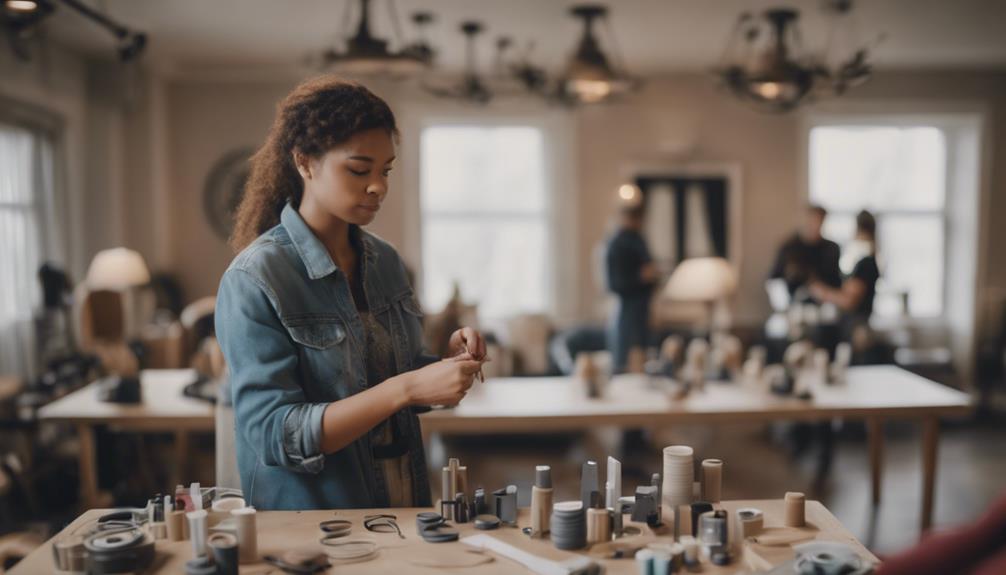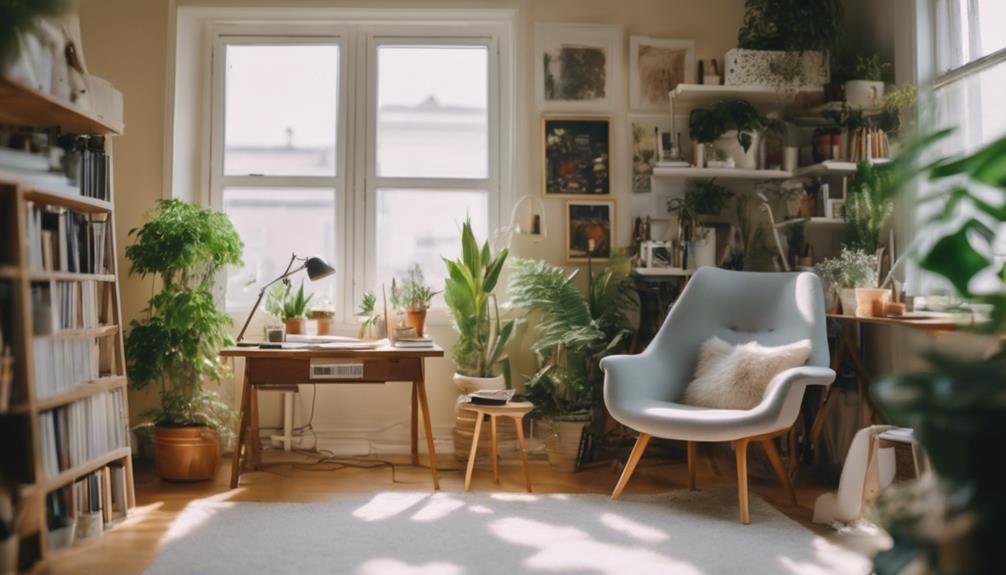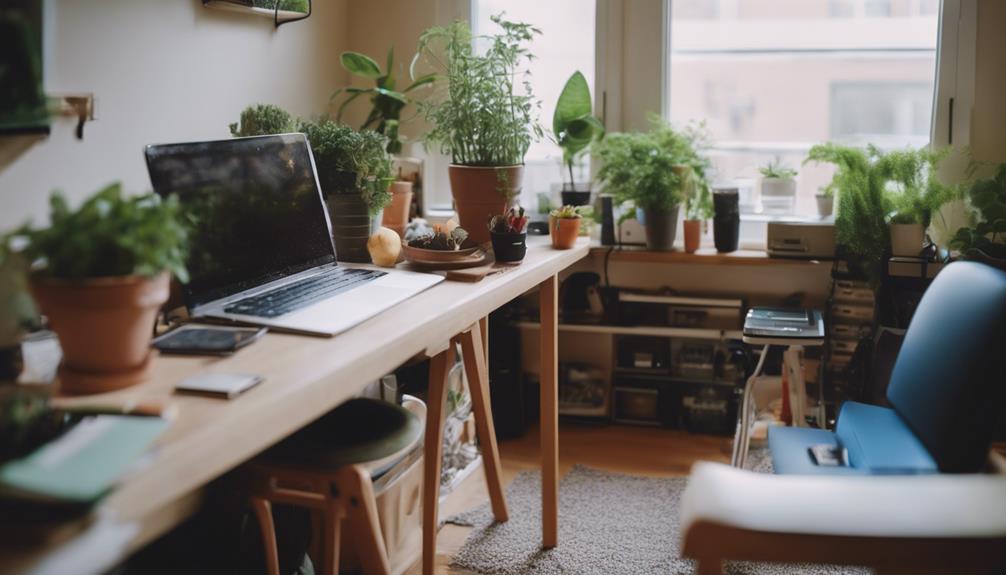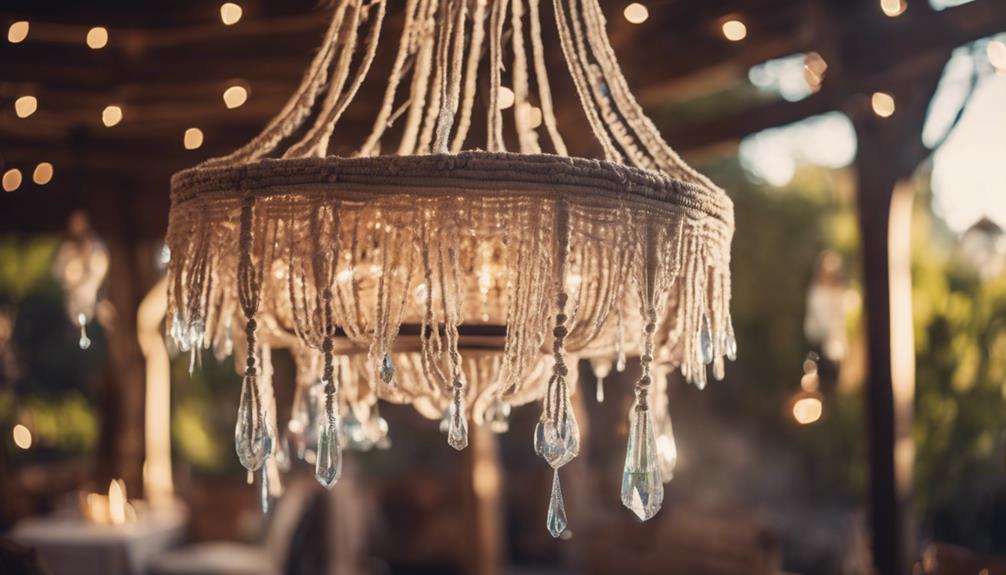Considering a shift in career towards home decor? Begin by exploring different design styles through research and mood boards. Enhance your skills by delving into design resources and keeping up-to-date with current trends. Establish a strong portfolio featuring high-quality images and client testimonials. Expand your professional network by connecting with experts and showcasing your work on social media. Gain practical experience through training, internships, and apprenticeships. Educate yourself with interior design courses and delve into color theory. Collaborate with industry professionals, gain hands-on experience, and understand the significance of using quality materials. Are you prepared to advance your career in home decor?
Key Takeaways
- Research popular design styles like modern, farmhouse, or Scandinavian.
- Develop essential design skills through courses and practice.
- Build a strong portfolio showcasing versatility and craftsmanship.
- Network with industry professionals at events and online platforms.
- Gain practical experience through internships, shadowing, and apprenticeships.
Discover Your Design Style
To begin your journey in home decor, explore different design styles that resonate with your personal taste and preferences. Start by researching popular styles like modern, farmhouse, bohemian, industrial, or Scandinavian.
Look at various home decor magazines, websites, and social media platforms for inspiration. Pay attention to the colors, textures, furniture types, and overall vibes that appeal to you the most.
Once you have gathered ideas, create a mood board or Pinterest board to visually organize your preferences. This will help you see patterns in the styles you're drawn to and narrow down your choices. Don't be afraid to mix elements from different styles to create a unique look that reflects your personality.
Visit furniture stores, home decor boutiques, and even open houses to see different design styles in real-life settings. Take note of what resonates with you and what doesn't.
Develop Essential Design Skills

Explore practical ways to enhance your design skills as you progress in your journey of discovering your design style in home decor. To begin with, immerse yourself in design resources like books, online courses, and workshops to grasp fundamental design principles such as color theory, spatial planning, and furniture arrangement.
Experiment with different styles and techniques to broaden your design knowledge and develop a versatile skill set.
Practice sketching and creating mood boards to visualize your ideas and effectively communicate them to clients. This hands-on approach will sharpen your creativity and help you refine your design concepts.
Additionally, seek opportunities to collaborate with experienced designers or mentors to gain valuable insights and feedback on your work.
Stay updated on the latest trends and innovations in the home decor industry by attending trade shows, following design blogs, and networking with other professionals. Continuously honing your skills and staying inspired will set you on the path to becoming a successful home decor designer.
Build a Strong Portfolio

Building a strong portfolio is essential for showcasing your design skills and attracting potential clients in the home decor industry. Your portfolio is a visual representation of your capabilities and style, allowing clients to see the quality of your work before deciding to hire you. Here are some key elements to keep in mind when including in your portfolio:
| Portfolio Component | Description |
|---|---|
| High-Quality Images | Include clear, professional photos of your design projects to highlight the details and craftsmanship. |
| Project Descriptions | Write brief descriptions for each project, explaining your design process, inspirations, and challenges you overcame. |
| Client Testimonials | Incorporate feedback from previous clients to showcase your professionalism and the satisfaction of your customers. |
| Variety of Styles | Display a range of design styles in your portfolio to demonstrate your versatility and ability to adapt to different preferences. |
Networking in the Industry

You can enhance your career prospects by actively engaging in industry networking. Building professional relationships can open doors to exciting opportunities in the home decor field.
Connect with others, attend events, and participate in online forums to expand your network and stay informed about industry trends.
Industry Networking Tips
Engaging with professionals at industry events can greatly enhance your networking efforts in the home decor field. Attending trade shows, conferences, and workshops provides valuable opportunities to connect with like-minded individuals, potential employers, and industry influencers. To make the most out of these events, consider these networking tips:
| Networking Tip | Description |
|---|---|
| Be Approachable | Smile, maintain eye contact, and engage in open conversations. |
| Exchange Contact Info | Always carry business cards and be ready to share your details. |
| Follow Up | After the event, send personalized follow-up emails to maintain connections. |
Remember to be genuine, show interest in others, and be prepared to talk about your own career aspirations and accomplishments. Building a strong network of contacts can lead to exciting opportunities within the home decor industry.
Building Professional Relationships
To establish strong connections in the home decor industry, actively participating in networking events and engaging with professionals is essential. Attending industry conferences, trade shows, and local meetups can provide valuable opportunities to meet potential collaborators, mentors, and clients.
Remember to introduce yourself confidently, exchange contact information, and follow up with a friendly email or LinkedIn connection request.
Networking isn't just about what others can offer you; it's also about how you can add value to their network. Be genuine in your interactions, listen actively, and offer assistance or insights where you can. Building relationships based on mutual respect and support can lead to long-lasting partnerships and career opportunities.
Utilize social media platforms like Instagram, Pinterest, and LinkedIn to showcase your work, connect with like-minded professionals, and stay updated on industry trends.
Engaging with online communities through comments, shares, and collaborations can also expand your network and visibility within the home decor field.
Gain Practical Experience

To gain practical experience in home decor, consider seeking hands-on training opportunities and shadowing industry experts.
These experiences can provide valuable insight into the day-to-day operations of the industry and help you develop essential skills.
Hands-On Training
Consider securing an internship or apprenticeship in the home decor industry to gain invaluable hands-on experience in the field. This practical training will allow you to apply your knowledge in real-world scenarios and develop essential skills that are vital for a successful career in home decor.
- Internship Opportunities: Look for internships at design firms, home decor stores, or interior design studios to get hands-on experience in different aspects of the industry.
- Apprenticeship Programs: Consider joining an apprenticeship program where you can learn directly from experienced professionals and gain insights into their techniques and processes.
- Networking Events: Attend industry events, trade shows, and workshops to connect with professionals in the home decor field and explore potential hands-on training opportunities.
- DIY Projects: Start with small do-it-yourself projects at home to practice your skills and experiment with different styles and techniques before taking on larger projects professionally.
Shadowing Industry Experts
Explore the opportunity to shadow industry experts in the home decor field to gain practical experience and firsthand insights into their daily work routines and techniques. Shadowing professionals allows you to observe real-world scenarios, understand client interactions, and learn about the latest trends in the industry. Here's a structured way to make the most of your shadowing experience:
| Activity | Description | Benefits |
|---|---|---|
| Attend client meetings | Observe how experts communicate with clients and present ideas | Learn effective communication and presentation skills |
| Assist with design projects | Help professionals in executing design plans and projects | Gain hands-on experience in implementing design concepts |
| Learn about sourcing | Accompany experts to suppliers and learn about materials | Understand the importance of quality materials in design |
Launching Your Home Decor Career

When beginning your journey into the home decor industry, focus on building a strong foundation through education and practical experience. This will pave the way for a successful career in creating beautiful living spaces that inspire and delight.
Here are four key steps to launch your home decor career:
- Education: Enroll in courses or workshops related to interior design, color theory, and home decor trends to gain valuable knowledge and skills.
- Gain Experience: Seek opportunities to work or intern with established interior designers or home decor firms to learn firsthand about the industry.
- Build a Portfolio: Showcase your creativity and style by creating a portfolio of your design projects, including before-and-after photos and client testimonials.
- Network: Attend industry events, join online communities, and connect with professionals in the field to expand your contacts and discover new opportunities.
Frequently Asked Questions
Can I Start a Home Decor Career Without a Formal Design Education?
You can definitely start a home decor career without a formal design education. Many successful decorators have honed their skills through hands-on experience, self-study, workshops, and networking. Passion, creativity, and dedication are key!
How Can I Stay Updated on the Latest Home Decor Trends?
To stay updated on the latest home decor trends, follow design blogs and social media accounts. Engage with interior design communities, attend trade shows, and explore new styles. Embrace change and infuse your space with fresh ideas!
Is It Necessary to Have a Specific Niche in Home Decor?
Having a specific niche in home decor isn't necessary, but it can help you stand out in a crowded market. It allows you to focus on a particular style or area of expertise, making your work more recognizable and appealing.
What Are Some Ways to Gain Practical Experience in Home Decor?
To gain practical experience in home decor, you can volunteer to assist with local design projects, intern at interior design firms, take online courses, attend workshops, and practice decorating your own space.
How Do I Handle Pricing and Budgeting for Home Decor Projects?
When tackling pricing and budgeting for home decor projects, remember this: You've got to be the Sherlock Holmes of numbers, with a magnifying glass on every penny. Scrutinize, calculate, and negotiate like a budgeting ninja!
How Can Starting a Home Decor Blog Help in Transitioning to a Career in Home Decor?
Starting a home decor blog can be a great way to showcase your passion and knowledge for interior design. By creating consistent and engaging content, you can build a strong online presence and attract potential clients or employers. It also allows you to practice your writing skills and network with others in the industry.
Conclusion
You're now ready to take the home decor world by storm! With your impeccable design style, essential skills, strong portfolio, industry connections, and practical experience, you're a force to be reckoned with.
Get ready to launch your career and make a name for yourself in the home decor industry. The only way is up from here – so go forth and decorate the world!









